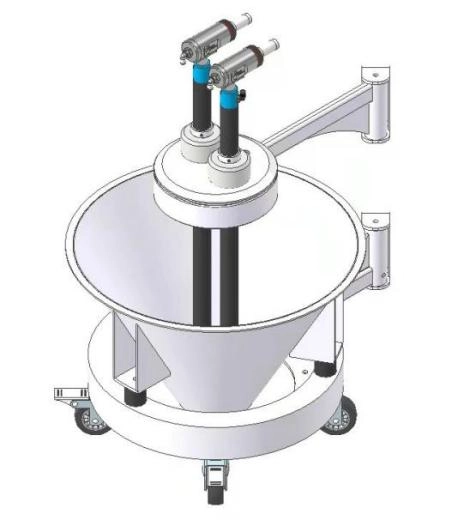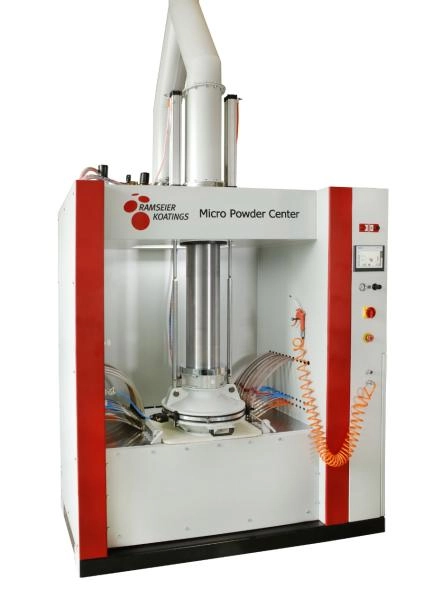Content Menu
● Understanding the Role of a Powder Hopper in Coating Lines
>> What is a Powder Hopper?
>> Importance of Powder Hoppers in Coating Systems
● Key Features of a Well-Designed Powder Hopper
>> Optimal Hopper Geometry and Size
>> Air-Fluidization and Agitation Systems
>> Moisture and Contamination Control
>> Ease of Cleaning and Maintenance
● How a Well-Designed Hopper Boosts Coating Line Performance
>> Ensures Consistent Powder Flow and Feed Rate
>> Reduces Material Waste and Increases Powder Utilization
>> Minimizes Downtime and Maintenance Interruptions
>> Improves Coating Quality and Finish Uniformity
>> Enhances Operator Safety and Ergonomics
● Design Considerations for Implementing an Efficient Powder Hopper
>> Material Selection for Hopper Construction
>> Integration with Powder Coating Equipment
>> Automation and Monitoring Capabilities
>> Scalability and Flexibility for Future Needs
● Case Study Example: Transformation Through a Well-Designed Powder Hopper
● Common Challenges and Solutions in Powder Hopper Design
>> Challenge: Powder Bridging and Rat Holing
>> Challenge: Moisture Ingress Affecting Powder Quality
>> Challenge: Frequent Color Changes Increasing Downtime
>> Challenge: Dust Generation Compromising Health and Equipment
● Future Trends in Powder Hopper Technology
>> Smart Hopper Systems
>> Eco-Friendly Materials and Designs
>> Enhanced Customization
● Conclusion
● Related Questions & Answers
>> 1. Why is powder flow consistency important in coating lines?
>> 2. How does air-fluidization improve hopper performance?
>> 3. What maintenance practices are recommended for powder hoppers?
>> 4. Can hopper design affect worker safety?
>> 5. What are common hopper shapes and their advantages?
In modern industrial operations, coating lines play a pivotal role in producing high-quality finishes on various products, from automotive parts to household appliances. Among the many components that contribute to an efficient coating process, the powder hopper is often overlooked. However, the design and functionality of a powder hopper can significantly influence the entire coating line's performance. This article explores how a well-designed powder hopper enhances coating line efficiency, product quality, and operational reliability.

Understanding the Role of a Powder Hopper in Coating Lines
What is a Powder Hopper?
A powder hopper is a containment unit used to store and feed powder coatings onto substrates during the coating process. It is an integral part of a powder coating system, ensuring that powders are delivered consistently and evenly to the coating equipment. The hopper holds the powder until it is ready to be fed into the spray gun or application system.
Importance of Powder Hoppers in Coating Systems
Powder hoppers serve multiple critical purposes such as:
- Maintaining a consistent supply of powder material
- Preventing contamination and moisture absorption
- Facilitating smooth and controlled powder flow
- Reducing powder agglomeration to avoid clogs and defects
A poorly designed hopper can lead to uneven powder distribution, system downtime, increased material waste, and inferior coating quality.
Key Features of a Well-Designed Powder Hopper
Optimal Hopper Geometry and Size
The shape and volume of the hopper must match the production needs and material characteristics. Common shapes include conical, wedge, and pyramid designs, each offering different advantages:
- Conical hoppers provide smooth gravity flow, reducing powder buildup.
- Wedge hoppers can be beneficial for materials prone to bridging.
- Pyramid hoppers are often used for compact design and ease of cleaning.
Selecting the right size ensures sufficient powder supply without overfilling or frequent refilling interruptions.
Air-Fluidization and Agitation Systems
One of the significant challenges with powder handling is avoiding clumping and bridging inside the hopper. Incorporating air-fluidization systems or mechanical agitators helps to:
- Keep the powder particles suspended and free-flowing
- Prevent compaction that leads to irregular feeding
- Enable uniform powder density as the coating line operates
These features prevent blockages and maintain consistent powder output.
Moisture and Contamination Control
Powder coatings are highly sensitive to moisture and contaminants, which can degrade finish quality. A good powder hopper design includes airtight seals, humidity control features, and sometimes nitrogen purging options to:
- Protect the powder from absorbing moisture
- Keep the hopper environment clean and dry
- Extend powder shelf life and maintain coating performance
Ease of Cleaning and Maintenance
Frequent cleaning is essential to prevent color contamination and build-up inside the hopper. A well-designed hopper features smooth internal surfaces, quick-release components, and accessible openings to:
- Expedite cleaning processes between color changes
- Minimize production downtime
- Facilitate hygienic handling of coating materials
Maintenance-friendly designs reduce labor costs and improve operational uptime.
How a Well-Designed Hopper Boosts Coating Line Performance
Ensures Consistent Powder Flow and Feed Rate
A stable and uniform flow of powder is critical for achieving an even coating thickness. A well-engineered hopper with proper flow modifiers avoids flow disruptions such as arching or ratholing inside the powder bed. This consistency translates into fewer defects, less rework, and better product quality.
Reduces Material Waste and Increases Powder Utilization
Inefficient powder flow usually results in powder accumulation or spillage that wastes material. Precision in powder delivery enabled by a good hopper design means:
- Less overspray and powder loss
- Lower overall powder consumption
- Improved cost efficiency in material usage
Minimizes Downtime and Maintenance Interruptions
Blockages, bridging, and cleaning delays can cause unexpected halts in the coating line. Features like air-fluidization and easy maintenance reduce the frequency and duration of these interruptions. As a result, production runs are longer and more predictable, increasing throughput.
Improves Coating Quality and Finish Uniformity
The end goal of any coating line is a flawless finish. When powder is supplied and applied uniformly, it prevents issues like:
- Uneven film thickness
- Orange peel texture or rough surfaces
- Pinholes and other coating defects
Achieving a professional finish enhances product appeal and reduces customer complaints.
Enhances Operator Safety and Ergonomics
Modern hopper designs often integrate ergonomic features for safe powder handling, such as:
- Low-dust operation to protect worker health
- Easy opening mechanisms to reduce strain
- Automated material feeding to minimize manual handling
This results in a safer and more comfortable working environment.
Design Considerations for Implementing an Efficient Powder Hopper
Material Selection for Hopper Construction
Choosing the right construction material ensures durability and compatibility with powders. Common materials include stainless steel or coated metals that resist corrosion and minimize static charges that can affect powder flow.
Integration with Powder Coating Equipment
The hopper must seamlessly connect with spray guns, feeders, and recovery systems. Proper integration ensures synchronized operation and reduces manual intervention.
Automation and Monitoring Capabilities
Incorporating sensors and automation enables real-time monitoring of powder level, flow rate, and environmental conditions. Automated systems can adjust hopper parameters dynamically, optimizing coating performance.
Scalability and Flexibility for Future Needs
A modular hopper design allows easy expansion or adaptation to different powders and production volumes, supporting business growth and changing product lines.
Case Study Example: Transformation Through a Well-Designed Powder Hopper
A mid-sized automotive supplier upgraded their powder coating line by replacing an outdated hopper with a newly designed, conical air-fluidized hopper. Within weeks, they observed:
- A 20% reduction in powder consumption due to precise delivery
- Over 30% fewer coating defects, especially thickness inconsistencies
- A 15% increase in line uptime by minimizing hopper-related blockages
- Enhanced operator satisfaction attributable to dust-free loading and easy cleaning
This example illustrates the tangible benefits realized from investing in better hopper design.
Common Challenges and Solutions in Powder Hopper Design
Challenge: Powder Bridging and Rat Holing
Solution: Apply air-fluidized beds and specialized flow aids to keep powders moving smoothly.
Challenge: Moisture Ingress Affecting Powder Quality
Solution: Use sealed hoppers with humidity controls and purge systems.
Challenge: Frequent Color Changes Increasing Downtime
Solution: Design for quick disassembly and cleaning with sanitary finishes to speed transitions.
Challenge: Dust Generation Compromising Health and Equipment
Solution: Incorporate dust collection and containment features integrated into hopper design.
Future Trends in Powder Hopper Technology
Smart Hopper Systems
Integration of IoT and AI-powered monitoring allows predictive maintenance and real-time optimization of powder flow, minimizing waste and downtime.
Eco-Friendly Materials and Designs
Focus on sustainability drives development of recyclable and low-impact hopper components.
Enhanced Customization
Manufacturers increasingly offer tailor-made hopper designs for niche powders and unique production environments.
Conclusion
A well-designed powder hopper is more than just a storage bin for powders—it is a vital component that directly impacts coating line efficiency, product quality, cost control, and operational safety. By understanding the critical features such as hopper geometry, flow assistance systems, moisture control, and ease of maintenance, manufacturers can choose or design powder hoppers that boost overall coating line performance. Continuous innovation and adoption of advanced hopper technologies ensure the coating process remains competitive, reliable, and scalable for future production demands.

Related Questions & Answers
1. Why is powder flow consistency important in coating lines?
Consistent powder flow ensures uniform coating thickness, reduces defects, minimizes material waste, and maintains overall product quality.
2. How does air-fluidization improve hopper performance?
Air-fluidization suspends powder particles, preventing compaction and bridging, thereby facilitating smooth and controlled powder feeding.
3. What maintenance practices are recommended for powder hoppers?
Regular cleaning, inspection for wear, checking seals for airtightness, and ensuring agitation or fluidization systems are operational are essential maintenance tasks.
4. Can hopper design affect worker safety?
Yes. Features like dust containment, ergonomics, and automated feeding reduce exposure to powders and physical strain, enhancing operator safety.
5. What are common hopper shapes and their advantages?
Conical hoppers promote gravity flow, wedge hoppers help with bridging powders, and pyramid hoppers offer compactness and ease of cleaning.
Hot Tags: China, Global, OEM, private label, manufacturers, factory, suppliers, manufacturing company










































 .
. 